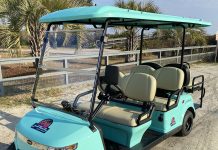PLEASE NOTE: Golf Cart Laws may vary from City to City, so please be sure to check with your local municipality in regards to the laws in your area. We are in the process of gathering laws by municipality for you, however, this is a huge undertaking and does take time. Thank you.
This is an in-depth guide to Texas Golf Cart & Low-Speed Vehicle Laws. We’ve created this guide to help you, the consumer, in determining Texas’s laws.
Is this state Medium Speed Vehicle friendly? No State Law is Currently in Place.
Is License and Registration a Requirement? For LSVs, yes. For Golf Carts, no. To register your LSV visit your county’s Tax Assessor-Collector Office.
General Federal Law for Golf Carts:
Under current NHTSA interpretations and regulations, so long as golf cars and other similar vehicles are incapable of exceeding 20 miles per hour, they are subject to only state and local requirements regarding safety equipment. However, if these vehicles are originally manufactured so that they can go faster than 20 miles per hour, they are treated as motor vehicles under Federal law.
The standard requires low-speed vehicles to be equipped with headlamps, stop lamps, turn signal lamps, taillamps, reflex reflectors, parking brakes, rearview mirrors, windshields, seat belts, and vehicle identification numbers.
Find out more information on federal laws pertaining to golf carts and low speed vehicles here.
Texas Golf Cart & Low Speed Vehicle Laws
Guidelines for Golf Carts and PTVs (Personal Transportation Vehicles)
Texas law classifies a vehicle as a golf cart if it:
- has no less than three wheels,
- has a maximum speed of between 15-25 mph, and
- is manufactured primarily for operation on golf courses.
REGISTRATION IS NOT REQUIRED FOR GOLF CARTS.
State law allows for use of golf carts with a slow-moving vehicle emblem in the following situations:
- in master planned communities with a uniform set of restrictive covenants in place,
- on public or private beaches,
- during the daytime and no more than two miles from where the owner usually parks the golf cart and for transportation to or from a golf course, or
- to cross intersections, including a road or street that has a posted speed limit of no more than 35 miles per hour.
A city can pass a local ordinance allowing for the use of golf carts on certain roads. The road must be within the boundaries of the city and have a speed limit of 35 mph or lower. The golf cart must be insured (with minimum liability insurance) and have the following equipment:
- headlamps,
- tail lamps,
- reflectors,
- parking brake,
- mirrors, and
- a slow-moving vehicle emblem.
Guidelines for LSV (Low Speed Vehicle)
- a normal maximum speed of 20-25 mph (LSV) or 20-35 mph (NEV)
- seat belts
- head and tail lights
- a windshield
- a parking brake
- turn signals
- rear-view mirrors
- brake lights
- reflectors
- a valid 17-digit Vehicle Identification Number (VIN).
To title and register your LSV or NEV, you must bring the following to the tax assessor-collector office:
- evidence of ownership, such as a Manufacturer Certificate of Origin or title,
- a completed Form 130-U, and
- proof of minimum liability insurance.
HELPFUL LINKS
Disclaimer
Although each of these state guides gives a thorough approach to the golf cart laws in your state, it is recommended that you perform the research on your own and reach out to your local municipality.
Recent News & Helpful Articles












